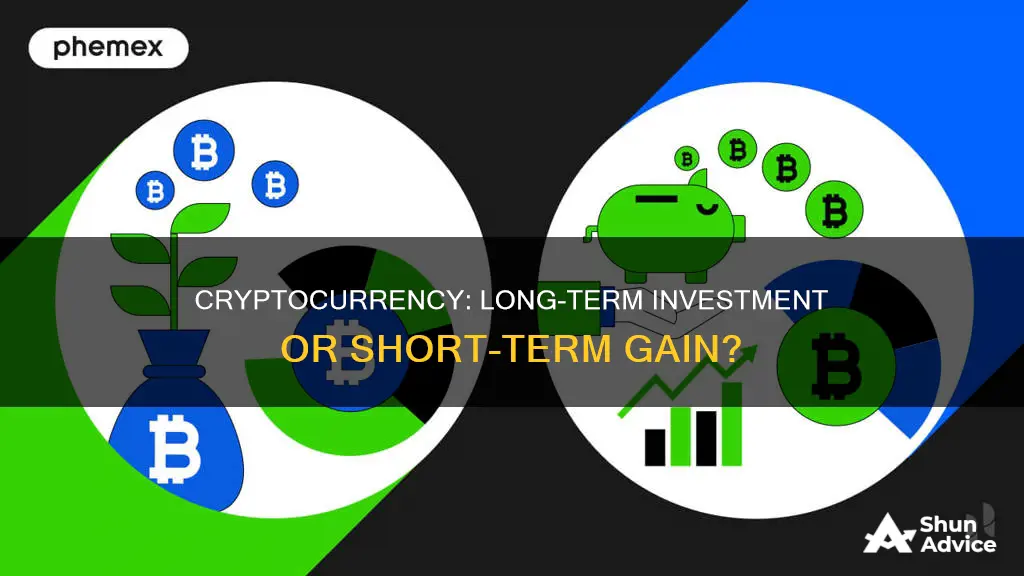
Cryptocurrency investment strategies can be broadly categorized into short-term and long-term approaches. Short-term crypto investment strategies involve buying and selling digital assets over a brief period, often within days, weeks, or even minutes, to profit from price fluctuations. This approach requires a keen understanding of market dynamics and quick decision-making skills. On the other hand, long-term crypto investment strategies entail holding digital assets for an extended period, typically years. Long-term investors are less concerned with daily price movements and instead focus on the potential long-term growth of cryptocurrencies. They emphasize assets with strong fundamentals and real-world utility, believing that the crypto market will trend upwards over time. The choice between short-term and long-term crypto investment strategies depends on individual goals, risk tolerance, and financial situation. Short-term crypto investments carry a higher level of risk but can lead to rapid returns. In contrast, long-term crypto investments are less risky but demand patience and a long-term perspective.
| Characteristics | Values |
|---|---|
| Time horizon | Short-term: Days or weeks |
| Long-term: Years | |
| Investment strategy | Short-term: Profit from price fluctuations |
| Long-term: Capitalize on long-term growth | |
| Risk | Short-term: Riskier due to market volatility |
| Long-term: Less risky but requires patience | |
| Returns | Short-term: Quick returns |
| Long-term: Long-term growth | |
| Investor profile | Short-term: Investors who need quick returns |
| Long-term: Investors who want to build wealth over time | |
| Investor behaviour | Short-term: Requires understanding of market trends and consumer behaviour |
| Long-term: Focus on a small number of currencies with high growth potential |
What You'll Learn

Short-term crypto investments
Day Trading
Day trading is one of the most well-known forms of aggressive short-term trading. It involves buying and selling cryptocurrencies within a day, aiming to take profits before the day ends. Day traders need to dedicate sufficient time to monitor the market and have a high risk tolerance due to the volatile nature of the crypto market. It is important to start with a small amount and gradually increase capital as you gain experience. Securing your crypto wallet is crucial, as online wallets are vulnerable to hacking.
Swing Trading
Swing trading is suitable for those who want to trade short-term without constantly monitoring the market. This strategy involves holding positions for a few days to weeks and profiting from short- to medium-term price swings. Swing traders often use range trading, where they buy at the bottom of a price range and sell at the top. Technical analysis skills are essential to identify these price ranges accurately.
Position Trading
Position trading is a less risky form of short-term trading, with holding periods of a few weeks. Traders identify market trends and ride them until the price hits a resistance or support level. This strategy requires technical analysis skills to identify trends and pullbacks. Similar to swing trading, position trading may involve holding positions overnight, which can impact tax rates in some countries.
Scalping
Scalping is the shortest-term trading strategy, with trades lasting from seconds to minutes. It involves frequent buying and selling to capitalise on minor price movements. However, individual traders rarely profit from scalping due to high commission fees and market risk. It is more suitable for enterprises with access to discount commission fees and large trading accounts.
Arbitrage
Arbitrage traders take advantage of price differences between cryptocurrency exchanges. They buy an asset on one exchange at a lower price and quickly sell it on another exchange at a higher price, profiting from the price disparity. This strategy requires quick execution and access to multiple exchanges.
Invest in CoinSwitch Kuber: A Beginner's Guide
You may want to see also

Long-term crypto investments
Strategies
- HODLing: This classic strategy involves buying promising cryptocurrencies and holding them through market ups and downs. The focus is on assets with strong fundamentals and real-world use cases.
- Dollar-Cost Averaging (DCA): This disciplined approach involves investing a fixed amount of money at regular intervals, regardless of the asset's price. This strategy helps to lower your average purchase price over time.
- Staking and Earning Rewards: Some cryptocurrencies offer staking opportunities where you can lock up your coins to support the network and earn rewards. By staking and compounding your earnings, you can grow your crypto holdings over time.
- Research-Backed Investments: Conduct due diligence and research projects with strong fundamentals, including teams with a track record, clear roadmaps, and partnerships.
- Diversification: Diversifying your portfolio across different assets can spread risk and enhance your chances of long-term success. Consider a mix of established cryptocurrencies like Bitcoin and Ethereum, along with promising altcoins.
Cryptocurrencies
- Pepe Unchained ($PEPU): Pepe Unchained is a Layer 2 blockchain designed for meme coin enthusiasts, offering faster transaction processing and lower fees compared to Ethereum. It facilitates instant bridging between Ethereum (ETH) and the Pepe Chain.
- MemeBet Token ($MEMEBET): MemeBet Token is a platform that allows users to bet with meme coins directly on Telegram. It combines gambling with meme culture, offering anonymous access, crypto-native games, and exclusive rewards for token holders.
- Crypto All-Stars ($STARS): Crypto All-Stars is a unique project that allows users to stake leading meme coins with a high APY during the presale phase. It appeals to both new and experienced investors with its affordable tokens and various payment options.
- Mega Dice Token ($DICE): Mega Dice Token operates on the Solana network and is integrated with the Mega Dice Casino platform. It offers casino cashback, airdrop rewards, and special NFT benefits, making it attractive to gambling and gaming enthusiasts.
- OppaCoin: OppaCoin fuses the global phenomenon of K-culture with artificial intelligence technology. It aims to provide users with interactive and immersive experiences with AI versions of their favorite K-pop idols.
- Ethereum (ETH): Ethereum is an open-sourced network that leverages smart contracts to allow developers to list decentralized applications (dApps), NFTs, and other protocols. It has a large developer community and has undergone upgrades to improve scalability and energy efficiency.
- Polygon (POL): Polygon is an open-source, permissionless platform deployed on Ethereum to act as a scalability solution. It leverages Layer 2 protocols to make Ethereum and other cryptocurrency networks more scalable and maintain low transaction fees.
- Bitcoin (BTC): Bitcoin was the first cryptocurrency introduced in 2008 and still accounts for a significant portion of the cryptocurrency market cap. It is widely accepted, integrated into financial systems, and seen as a hedge against inflation, making it attractive for long-term investors.
- Solana (SOL): Solana is an open-sourced blockchain that provides decentralized finance (DeFi) solutions and supports the creation of dApps through smart contracts. It offers higher scalability and can handle a large number of transactions per second at extremely low fees.
- XRP: XRP is the native crypto on the XRP ledger blockchain, used by hundreds of banks and financial institutions for cross-border payment settlements. It is highly decentralized, sustainable, and provides fast and affordable transactions, making it a good candidate for the world's bridge currency.
Real Money Coin Pusher: Worth the Investment?
You may want to see also

Risk tolerance and financial goals
When deciding between long-term and short-term crypto investment strategies, it's essential to consider your risk tolerance and financial goals. These factors will play a crucial role in shaping your investment approach and ensuring it aligns with your overall aspirations.
Risk Tolerance
Risk tolerance refers to your ability and willingness to withstand market volatility and potential losses. It's influenced by factors such as your personality, financial situation, and investment knowledge. Understanding your risk tolerance is key to choosing an investment strategy that suits your psychological and financial capacity. Short-term crypto investment strategies are generally riskier due to the fast-paced nature of trading and the need to react quickly to market volatility. If you're comfortable with taking on higher risks and have the time to closely monitor market movements, short-term trading may be suitable. On the other hand, long-term crypto investment strategies are typically considered less risky. This approach allows you to ride out short-term market fluctuations and focus on the long-term growth potential of cryptocurrencies. If you have a lower risk tolerance or prefer a more passive investment style, long-term investing may be a better fit.
Financial Goals
Your financial goals are another critical factor in determining your investment strategy. Are you seeking quick profits or aiming for long-term wealth accumulation? Short-term crypto investments are ideal for those who need to generate income rapidly or are looking for short-term returns. For instance, if you have a pressing financial obligation, such as debt repayment, short-term investments can provide a faster solution. On the other hand, long-term crypto investments are better suited for investors with a goal of building wealth over time. This strategy allows investors to benefit from the market's growth by holding digital assets with high growth potential over an extended period. If you're patient and have a long-term perspective, long-term crypto investments align well with your financial objectives.
In conclusion, the choice between long-term and short-term crypto investment strategies depends on your individual circumstances. Consider your risk tolerance and financial goals carefully to make an informed decision. Remember, there is no one-size-fits-all approach, and you can also diversify your portfolio by incorporating both short-term and long-term investments to balance risk and reward.
Raymond: Avoid Bitcoin for a Stable Financial Future
You may want to see also

Market volatility
The cryptocurrency market is highly volatile, and this volatility can be leveraged for short-term gains. Short-term crypto investment strategies involve buying and selling digital assets over a brief period, often days, weeks, or even minutes, to profit from price fluctuations. This approach requires a keen understanding of market dynamics and quick decision-making skills. Traders closely analyse cryptocurrency predictions, price trends, and price actions to make swift buy and sell decisions.
The high volatility of the crypto market means that prices can change rapidly, making it challenging to predict market trends accurately. This uncertainty can have serious consequences and result in significant losses. Therefore, short-term crypto trading is riskier than long-term investing.
Long-term crypto investment strategies, on the other hand, involve holding digital assets for an extended period, often years. Long-term investors are less concerned with daily price fluctuations and focus on the potential long-term growth of cryptocurrencies. They aim to capitalise on the transformative power of blockchain technology and believe that, despite its volatility, the crypto market will trend upwards over time.
While long-term crypto investments are less risky than short-term ones, they require patience and a long-term perspective. Long-term investors need to stay informed about cryptocurrency predictions and market trends, but they avoid making hasty decisions based on short-term price actions. Their success lies in their conviction that time is their most significant ally in the crypto world.
Bitcoin vs Bitcoin Cash: Which Crypto is the Better Investment?
You may want to see also

Crypto investment strategies
There are several crypto investment strategies that you can employ, depending on your financial goals, risk tolerance, and the time you're willing to commit. Here are some popular approaches:
- Buy-and-Hold Investing (Long-Term): This strategy involves purchasing cryptocurrencies and holding onto them for an extended period, typically several years. The idea is to weather short-term volatility and focus on the potential for substantial long-term gains.
- Dollar-Cost Averaging (Long-Term): This approach involves making regular, fixed investments at set intervals, such as weekly or monthly, regardless of the market conditions. By investing a consistent amount, you buy more when prices are low and less when they are high, ultimately lowering your average purchase price over time.
- Day Trading (Short-Term): Day trading is a fast-paced strategy where traders buy and sell cryptocurrencies within the same trading day, aiming to capitalise on intraday price fluctuations. It requires a good understanding of market dynamics, technical analysis, and quick decision-making skills.
- Swing Trading (Short-Term): Swing traders take a slightly longer-term approach, holding positions for several days to weeks. They aim to profit from short- to medium-term price swings by identifying trends and entering positions when they expect an asset's value to move in their favour.
- Arbitrage (Short-Term): Arbitrage traders exploit price differences for the same cryptocurrency on different exchanges. They buy at a lower price on one exchange and sell immediately at a higher price on another, profiting from the price difference. This strategy requires speed and access to multiple exchanges to be effective.
Key Considerations for Crypto Investment Strategies:
- Risk Tolerance: Short-term trading strategies are generally riskier due to the volatile nature of the crypto market. Long-term strategies tend to be less risky as they aim to ride out market downturns.
- Investment Goals: Short-term strategies are suitable for those seeking quick profits, while long-term strategies align with long-term wealth accumulation goals.
- Time and Effort: Short-term trading demands constant attention, research, and quick decision-making. Long-term investing is more passive and requires less frequent monitoring and trading.
- Tax Implications: In some countries, short-term gains are taxed at higher rates compared to long-term capital gains. Consider the tax implications of your chosen strategy as they can impact your overall returns.
- Diversification: Diversifying your portfolio by incorporating both short-term and long-term investments can help balance risk and reward.
Remember, there is no one-size-fits-all approach to crypto investment strategies. The best strategy depends on your individual circumstances, financial goals, risk tolerance, and level of commitment to researching and monitoring the market.
Monacoin Investment: Is It a Smart Move?
You may want to see also
Frequently asked questions
Short-term investment involves buying and selling cryptocurrencies over a brief period, often days or weeks, to profit from price fluctuations. Long-term investment, on the other hand, involves holding cryptocurrencies for an extended period, usually years, with the aim of capitalising on their long-term growth.
Short-term cryptocurrency investment can result in quick returns. It is a good strategy for investors who need to make money quickly or who are looking for rapid returns.
Short-term cryptocurrency investment is riskier than long-term investment due to the market's significant volatility. It also requires a keen understanding of market dynamics and quick decision-making skills.







